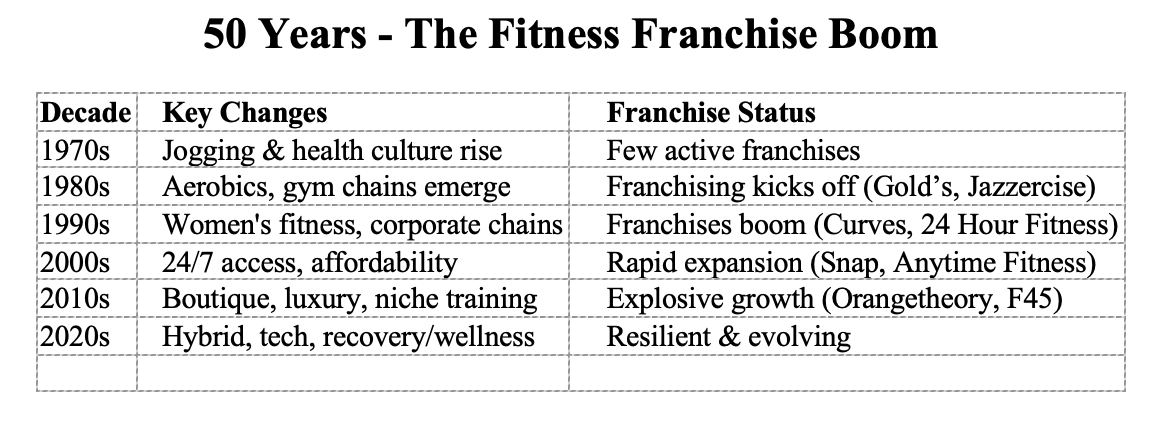50 Years of Fitness Franchises – Then and Now

From Jazzercise to AI: The Evolution of Franchised Fitness from 1975 to 2025
Over the past five decades, the franchised fitness industry has undergone a remarkable transformation. From its humble beginnings in the mid-1970s to the technologically advanced and wellness-focused landscape of 2025, the industry reflects broader societal shifts in health consciousness, technological innovation, and consumer preferences.
The 1970s: The Dawn of Franchised Fitness
In 1975, the concept of franchised fitness was still in its infancy. One of the earliest pioneers was Jazzercise, founded in 1969 by Judi Sheppard Missett. Combining dance, aerobics, and strength training set to music, Jazzercise offered a fun and accessible workout, quickly gaining popularity across the United States.
Another significant development was the establishment of Powerhouse Gym in 1974 by brothers William and Norman Dabish in Michigan. Initially a local gym catering to professional athletes, it began licensing its brand in 1984, paving the way for future fitness franchises.
During this era, fitness centers were primarily focused on bodybuilding and aerobic classes. The industry lacked the technological advancements and diversified offerings seen today.
2025: A Technologically Advanced and Holistic Approach
Fast forward to 2025, the franchised fitness industry has evolved into a multifaceted ecosystem that integrates technology, personalization, and holistic wellness.
Technological Integration
Modern fitness franchises leverage advanced technologies to enhance user experience:
- Artificial Intelligence (AI) and Machine Learning: These technologies analyze individual health data to create personalized workout plans, adapting in real-time to user progress.
- Wearable Technology: Devices like smartwatches and fitness trackers provide real-time metrics, allowing for more informed training decisions.
- Virtual and Augmented Reality (VR/AR): Immersive experiences, such as virtual cycling through scenic landscapes, are becoming standard offerings in many gyms.
Hybrid Membership Models
The pandemic accelerated the adoption of hybrid fitness models, combining in-person and virtual classes. Members now expect seamless integration between physical gyms and digital platforms, with features like live-streamed classes and on-demand workout libraries.
Holistic Wellness Focus
Modern fitness franchises recognize the importance of mental health and recovery in overall wellness:
- Recovery Services: Offerings such as cryotherapy, massage therapy, and infrared saunas are becoming commonplace.
- Mental Health Support: Workshops on mindfulness, meditation, and nutrition counseling address the growing demand for mental well-being resources.
Sustainability and Eco-Consciousness
Environmental sustainability is a priority for many fitness franchises:
- Green Infrastructure: Gyms are investing in renewable energy sources and eco-friendly building materials.
- Waste Reduction: Initiatives include reducing single-use plastics and promoting recycling programs.
Decade-by-Decade: The Evolution of the U.S. Franchise Fitness Industry
1970s: Jogging & Health Awareness
- Cultural shift: Bill Bowerman’s “Jogging” book (1966) and Jim Fixx’s “Complete Book of Running” (1977) helped launch a jogging boom.
- Fitness becomes lifestyle: People began exercising for health, not just performance.
- Gyms: Still mostly independent. Aerobics, racquetball, and universal gyms started appearing.
- Franchise scene:
- Still minimal. Only a couple of brands had scaled (e.g., Jack LaLanne’s gyms).
- Health clubs were regionally known, rarely nationally.
1980s: Aerobics & Franchise Boom Begins
- Culture: Jane Fonda’s workout videos explode; the aerobics craze is born.
- Tech: Rise of VHS helps at-home workouts thrive.
- Gyms:
- Shift toward big-box gyms with full amenities.
- Racquetball, saunas, swimming pools became common.
- Franchise Growth:
- Gold’s Gym begins franchising (1980)
- Bally Total Fitness expands nationally, often buying up other brands.
- Jazzercise (founded 1969) becomes a massive franchise in the 80s.
- Weight Watchers expands into wellness and fitness.
- Fitness becomes mainstream for suburban middle-class adults.
1990s: Commercialization & Women’s Fitness
- Cultural focus: Shift toward weight loss, toning, and convenience.
- Gyms:
- More chains: 24 Hour Fitness, Crunch, LA Fitness
- Specialized clubs for women rise: Curves (1992) becomes a global franchise.
- Franchise Expansion:
- Fitness franchises become more standardized and franchising models mature.
- Curves becomes one of the fastest-growing franchises in history at its peak.
2000s: Convenience & Personalization
- Technology: iPods, early wearables, online workouts.
- Trends:
- 24/7 access gyms become popular: Snap Fitness (2003), Anytime Fitness (2002).
- Emphasis on short, intense workouts: HIIT begins gaining ground.
- Franchise Scene:
- Huge boom in affordable, no-frills gyms.
- Anytime Fitness and Snap Fitness dominate the franchising space.
- Brand Strategy: Fitness becomes less intimidating and more accessible.
2010s: Boutique & High-Tech Boom
- Trends:
- Rise of boutique fitness studios: smaller, specialized, community-driven.
- Categories explode: spin (SoulCycle), rowing (Row House), boxing (Rumble), HIIT (F45), yoga (CorePower).
- Luxury fitness and "Instagrammable" workouts.
- Franchise Growth:
- Orangetheory Fitness (founded 2010) becomes one of the fastest-growing fitness franchises ever.
- F45, Club Pilates, Pure Barre, CycleBar — all part of the Xponential Fitness empire.
- Tech: Peloton, Apple Watch, online coaching, fitness apps — fitness goes digital.
2020s (So Far): Hybrid, Virtual, & Wellness Integration
- COVID-19 Impact:
- Gym closures fuel a huge shift to virtual fitness.
- At-home equipment (Peloton, Tonal, Mirror) explodes.
- Franchises pivot to online + in-person (“hybrid” models).
- Franchise Resilience:
- Brands like Orangetheory and Anytime Fitness adapt well due to strong member communities and digital options.
- Trends:
- Focus on recovery, mental health, holistic wellness.
- Rise of wellness franchises: cryotherapy, IV therapy, float spas, etc.
- Wearables and data-driven training.
The franchised fitness industry has transformed from simple aerobics classes and bodybuilding gyms into technologically advanced, holistic wellness centers. This evolution reflects broader societal changes, including increased health consciousness, technological advancements, and a focus on sustainability. As we look to the future, the industry is poised to continue innovating, offering personalized and comprehensive wellness solutions to meet the diverse needs of its members. There is truly a fitness option for any type of health-conscious consumer, and for every entrepreneur who wants to own a fitness franchise!
About the Author
Joe Fox has spent his professional career as a Senior Executive owning, operating, buying, and selling multi-site businesses. He believes entrepreneurship is a great vehicle to financial independence and career satisfaction. Joe is based in Nashville, TN and has helped startup businesses all over the US & Canada and has won numerous prestigious awards throughout his career. Contact Joe at
joefox@thefranchiseconsultingcompany.com.










